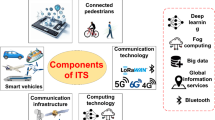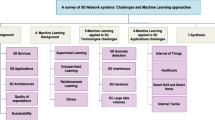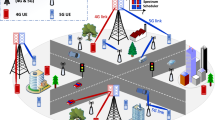Abstract
Cognitive Radio has been one of the key research topics in the wireless community for about 10 years. The digital switch-over in the TV bands provides opportunities for Cognitive Radio Systems (CRS) to operate in the 470–790 MHz spectrum under incumbent protection restrictions. Locally unused spectrum in this band is often referred to as TV whitespace (TVWS). Regulatory bodies, in particular the US Federal Communications Commission (FCC) and Ofcom in the UK, have specified parameters under which CRS shall operate. In this paper we analyse key scenarios for CRS stemming from the QoSMOS project. We then analyse how these scenarios can be mapped into the TV whitespace (TVWS) context by considering link budget computation based on FCC and Ofcom transmit power recommendations plus statistical propagation models for the UHF band. We also consider the expected capacity which can be achieved when using TVWS as a capacity extension in an LTE network. We also show how cognitive femtocells can be used to provide outdoor coverage when deployment is based on random location. We eventually conclude on the most promising scenarios in the context of the TVWS usage.












Similar content being viewed by others
References
IEEE 802.19 Task Group 1: Wireless Coexistence in the TV White Space. http://ieee802.org/19/pub/TG1.html. Accessed 19 October 2012.
QoSMOS project website. http://www.ict-qosmos.eu/. Accessed 9 October 2012.
MacKenzie, R., Lehne, P. H., Celentano, U., Ariyoshi, M., & Cendón, B. (2010). QoSMOS consolidated scenarios. FP7-ICT-2009/248454 QoSMOS Project Deliverable D1.2.
Mueck, M., & Noguet, D. (2011). TV white space standardization and regulation in Europe. 2nd International Conference on Wireless Communications, Vehicular Technology, Information Theory and Aerospace in Electronic Systems Technology (Wireless VITAE), Chennai, India, March 2011.
Lehne, P. H., Celentano, U., Lehtomäki, J., Noguet, D., Datta, R., Delahaye, P., et al. (2011). QoSMOS consolidated system requirements. FP7-ICT-2009/248454 QoSMOS Project Deliverable D1.4.
Noguet, D., Datta, R., Lehne, P. H., Gautier, M., & Fettweis, G. (2011). TVWS regulation and QoSMOS requirements. 2nd International Conference on Wireless Communications, Vehicular Technology, Information Theory and Aerospace in Electronic Systems Technology (WirelessVITAE), Chennai, India, March 2011.
Grøndalen, O., Lähteenoja, M., Lehne, P. H., MacKenzie, R., & Kawade, S. (2012). Economic benefits for a QoSMOS system. FP7-ICT-2009/248454 QoSMOS Project Deliverable D1.6.
Lehne, P. H., MacKenzie, R., Grøndalen, O., Grønsund, P., & Briggs, K. (2012). Business opportunities and scenarios for cognitive radio systems. QoSMOS white paper. http://www.ict-qosmos.eu/fileadmin/documents/Dissemination/White_Papers/QoSMOS_White_Paper_1_Scenarios_and_business_opportunities_V1.1_April2012-_final.pdf. Accessed at 9 October 2012.
Mange, G., Rosik, C., Arisyoshi, M., Lehne, P., Rico, J., Celentano, U., et al. (2012) Quality of service in cognitive radio systems: system architecture options and detailed functions. QoSMOS white paper. http://www.ict-qosmos.eu/fileadmin/documents/Dissemination/White_Papers/QoSMOS_WP2__White_Paper.pdf. Accessed at 9 October 2012.
QoSMOS TVWS Prototype Database. http://test.tst-sistemas.es/QoSMOS/. Accessed 9 October 2012.
Arshad, K., Briggs, K., Depierre, D., Gameiro, A., Moessner, K., Noguet, D., et al. (2012). Cognitive context acquisition. QoSMOS white paper. http://www.ict-qosmos.eu/fileadmin/documents/Dissemination/White_Papers/WP3_20White_20paper_20-_20Final.pdf. Accessed 9 October 2012.
Noguet, D., Gauthier, M., & Berg, V. (2011). Advances in opportunistic radio technologies for TVWS. EURASIP Journal on Wireless Communications and Networking, Nov 2011. doi:10.1186/1687-1499-2011-170.
Noguet, D., Berg, V., Schuler, M., & Tessema, M. (2012). T-Flex: a mobile SDR platform for TVWS flexible operation. IEICE SR: Workshop on QoS & Mobility in Cognitive Communications, Fukuoka, Japan, 19 October 2012.
Akyildiz, I., Lee, W.-H., & Chowdhury, K. (2009). CRAHNs: Cogntive Radio Ad Hoc Networks. Elsevier Ad Hoc Networks Journal, 7(5), 810–836.
Federal Communications Commission. (2009). FCC final rule: unlicensed operation in the TV broadcast bands. US Federal Register, 74(30), 7314–7332. Feb. 17 2009.
Ofcom. (2009). Digital dividend: cognitive access, statement on licence-exempting cognitive devices using interleaved spectrum, Ofcom, July 2009. http://stakeholders.ofcom.org.uk/binaries/consultations/cognitive/statement/statement.pdf. Accessed 30 Mar 2012.
European Telecommunications Standards Institute. (2005). Digital video broadcasting (DVB); DVB-H implementation guidelines. ETSI TR 102 377 V1.2.1.
European Broadcasting Union (EBU). (2007). Planning parameters for hand held reception. Concerning the use of DVB-H and T-DMB in bands III, IV, V and the 1.5 GHz band. EBU Technical Report TECH 3317 v2.0. EBU, Geneva.
ITU-R. (2012). Propagation data and prediction methods for the planning of indoor radiocommunication systems and radio local area networks in the frequency range 900 MHz to 100 GHz. Recommendation ITU-R P.1238-7. ITU, Geneva.
ITU-R. (2012). Propagation data and prediction methods for the planning of short-range outdoor radiocommunication systems and radio local area networks in the frequency range 300 MHz to 100 GHz. Recommendation ITU-R P.1411-6. ITU, Geneva.
ITU-R. (2009). Method for point-to-area predictions for terrestrial services in the frequency range 30 MHz to 3 000 MHz. Recommendation ITU-R P.1546-4. ITU, Geneva.
3rd Generation Partnership Project. (2010). 3rd generation partnership project; technical specification group radio access network; Evolved Universal Terrestrial Radio Access (E-UTRA); further advancements for E-UTRA physical layer aspects (Release 9). 3GPP TR 36.814 V9.0.0, Mar 2010.
SEAMCAT – Spectrum Engineering Advanced Monte Carlo Analysis Tools. http://www.seamcat.org. Accessed 9 October 2012.
3rd Generation Partnership Project. (2010). 3rd generation partnership project; technical specification group radio access network; Evolved Universal Terrestrial Radio Access (E-UTRA); Radio Frequency (RF) system scenarios (Release 9). 3GPP TR 36.942 9.2.0. December 2010.
Electronic Communication Committee. (2004). Technical Criteria of Digital Video Broadcasting Terrestrial (DVB-T) and Terrestrial Digital Audio Broadcasting (T-DAB) allotment planning, CEPT/ERO, ECC Report 49, Copenhagen, 2004.
Lazos, L., & Poovendran, R. (2006). Stochastic coverage in heterogeneous sensor networks. ACM Transactions on Sensor Networks (TOSN), 2(3), 325–358.
Acknowledgments
The research leading to these results was derived from the European Community’s Seventh Framework Programme (FP7) under Grant Agreement number 248454 (QoSMOS).
Author information
Authors and Affiliations
Corresponding author
Additional information
The research leading to these results was derived from the European Community’s Seventh Framework Programme (FP7) under Grant Agreement number 248454 (QoSMOS). Some of the results were originally presented at the Wireless Innovation Forum’s SDR’12 – WinnComm-Europe conference, Brussels, Belgium, 27–29 June 2012.
Rights and permissions
About this article
Cite this article
Lehne, P.H., Grøndalen, O., MacKenzie, R. et al. Mapping Cognitive Radio System Scenarios into the TVWS Context. J Sign Process Syst 73, 227–242 (2013). https://doi.org/10.1007/s11265-013-0761-3
Received:
Revised:
Accepted:
Published:
Issue Date:
DOI: https://doi.org/10.1007/s11265-013-0761-3




